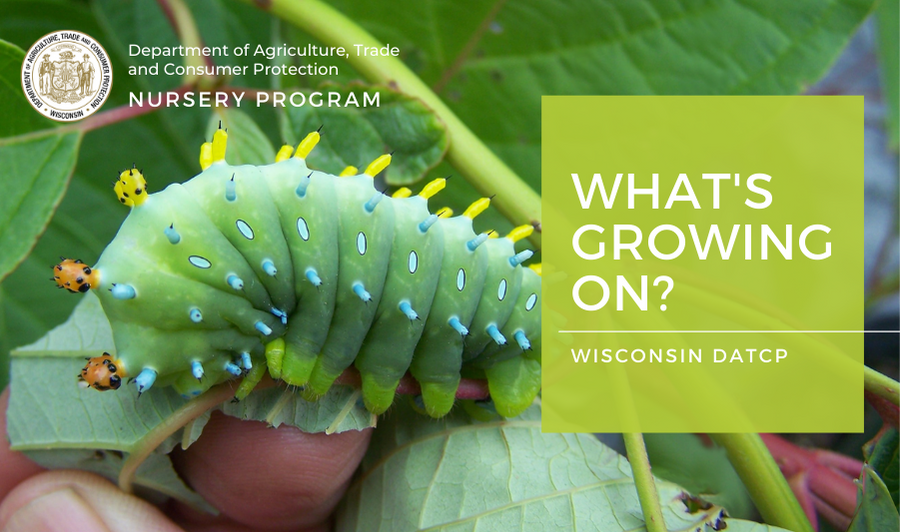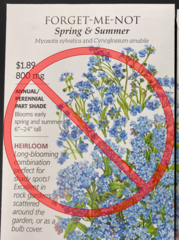|
 _____________________________________
Dear Wisconsin nurseries, Christmas tree growers, and gardeners:
Degree day accumulations as of July 13th were 1353 in Madison, 1274 in Racine, 1213 in Green Bay, and 1041 in Wausau. With locations throughout the southern half of the state already surpassing 1200 growing degree days, insects to be scouting for are Fletcher Scale and Cottony Maple Scale active crawlers and adult Japanese beetles and Viburnum leaf beetles.
Take a moment to read through a few updates from the DATCP nursery program.
Please send any feedback, questions, or ideas for future e-news updates to datcpnursery@wisconsin.gov.
Having trouble viewing this email? View it as a Web page.
_____________________________________
|
|
|
Tree spader harvesting stock for a landscaping job | DATCP K. Jerabek
|
|
|
Landscapers or arborists often purchase, resell, and install nursery stock for clients throughout the growing season, and because of that, they are considered nursery dealers in Wisconsin. A Nursery Dealer is any business or individual who buys nursery stock from a wholesaler or distributor and resells the nursery stock. Nursery stock includes any bulbs, shrubs, trees, and perennials that can overwinter in Wisconsin.
If you own or operate a landscape or tree care service and sell more than $250 from plant sales per calendar year in perennial plants, shrubs or trees, Wisconsin’s nursery law (Wis. Stat. § 94.10) requires that you obtain an annual nursery dealer license. Nursery dealer licensing fees are actually based on perennial purchasing costs, and start at just $30.
DATCP has been licensing and inspecting nursery dealers and growers in Wisconsin for more than 100 years in an effort to monitor and control the unintentional spread of regulated, harmful plant pests and diseases. In addition to surveying for regulated pests, DATCP nursery inspectors serve as a resource for other plant pest or disease issues you may encounter. Once licensed, a nursery dealer receives regular inspections of nursery stock, typically every one to three years, as well as outreach about emerging plant pests and diseases. In the event a pest or disease might be impacting your nursery stock, nursery dealers in Wisconsin also benefit from Plant Industry Bureau lab diagnostic services, at no charge to your business.
Please contact the DATCP Nursery Program to learn more about Nursery Dealer licensing by calling or emailing: 608-224-4572, DATCPNursery@Wisconsin.gov.
Wondering if someone down the road has a nursery license? All businesses licensed with Wisconsin nursery licenses and Christmas tree grower’s licenses are publicly listed on the MyDATCP "Registries/Lists" portal.
How to report a business that may be operating without a license? If you have a question about a license or if you want to report a business operating without a license please contact the nursery program at (608) 224-4572 or DATCPnursery@wisconsin.gov.
All tips and inquiries received are treated anonymously.
_____________________________________
|
|
|
Symptoms of Iris Severe Mosaic Virus (potyvirus ISMV) on iris | DATCP A. Phibbs
|
|
|
Did you know there is no known cure for plant viruses? Some plant viruses pose a serious threat to horticultural plants and economically important agricultural crops. For example, Tobacco Rattle Virus (TRV) and Tobacco Mosaic Virus (TMV) are highly transmissible and threaten solanaceous crops like potatoes and tomatoes. TRV and TMV have been found in the horticultural trade on astilbes, bleeding hearts, daffodils, tulips, begonias, geraniums, and petunias (to name a few). For some other plant viruses, the host range and severity is not well understood.
Iris severe mosaic virus (ISMV) is a type of potyvirus that commonly infects bearded irises (Iris germanica). It can spread through insects like sap-sucking aphids and mechanically on tools through the process of rhizome division. Symptoms are variable with severe cases appearing as stunted growth and mosaic coloration on leaves, while minor cases can be asymptomatic. Additionally, ISMV is not known to affect agricultural crops.
In order to gain insights into the most appropriate response to ISMV, which has been commonly detected on iris at nurseries, DATCP partnered with Dr. Derrick Grunwald and Dr. Renee Rioux at the University of Wisconsin-Madison to investigate the prevalence of potyvirus in the horticultural trade and determine if the virus poses a serious threat to native irises or other plants. Researchers sampled bearded, native, and Siberian irises across five counties in Wisconsin and tracked symptom development on a subset of plants throughout the growing season. They found 84% of bearded irises to be positive for potyvirus, while 0% of native and Siberian irises were positive for potyvirus. In addition, potyvirus symptoms within a plant varied throughout the growing season, with milder symptoms appearing at the end of the growing season (October).
In conclusion, (1) since ISMV is found primarily in bearded irises and not native or Siberian irises, and (2) ISMV symptoms in bearded are highly variable, even throughout a growing season, Dr. Grunwald’s research suggests that ISMV found on bearded irises in the horticultural trade seems to pose no threat to native or Siberian irises.
_____________________________________
|
|
|
Blister Beetles feeding on Baptisia | M. J. Slone
|
|
|
The past month saw a noticeable uptick in reports of blister beetle activity at nurseries in Bayfield, Iron, and Polk Counties in northern Wisconsin. Most nurseries reported the long, narrow beetles feeding on baptisia (false indigo) flowers. Siberian iris, lupin, delphinium, and thermopsis were also noted victims of the dark, ravenous beetles. In one instance, blister beetle numbers were so high that they caused complete defoliation and not just a loss of flowers. Blister beetles are also known to feed on peashrub (caragana), alfalfa, and potato.
Blister beetles get their name from a defensive chemical called cantharidin that they can exude when threatened that causes blisters on skin. This can be an issue for gardeners and for domestic animals if blister beetles get caught up in feed bales during haying operations; hay bales destined for animal feed found to be infested with blister beetles should be disposed of. Gardeners are encouraged to wear rubber gloves before attempting to handle blister beetles. Small swarms may be controlled by knocking feeding beetles into a bucket of soapy water.
_____________________________________
|
|
|
DATCP's staff will be exhibiting at some upcoming events. Stop by and visit with us, and learn about the latest plant pest and disease issues.
July 12-14 - Farm Technology Days in Loyal.
Visit DATCP’s Farm Center team in the Progress Pavilion to learn more about the free and confidential services available to farmers and their families, including financial consulting, transition planning, mediation, veterinary analysis, and access to mental health services and resources. You can also find USDA-APHIS-PPQ staff with information about plant pests that threaten Wisconsin’s environment and agriculture such as Emerald Ash Borer, Asian Longhorned Beetle and Spotted Lanternfly.
August 4-14 - Wisconsin State Fair in West Allis.
DATCP will have a booth in the Products Pavilion. This year the theme is ‘Connecting Wisconsin’s People and Products’.
August 9-11 - Garden Center Show in Milwaukee.
DATCP's Plant Protection section will be in booth #2329 offering information about the latest pests and pathogens of concern.
August 25-27 - Wisconsin Christmas Tree Producers Association Summer Convention in Merrill. DATCP will have a booth at the Merrill Festival Grounds.
_____________________________________
|
|
|
Viburnum leaf beetle larvae and their feeding damage | DATCP E. Graves
|
|
|
Viburnum leaf beetle (VLB), a native of Europe, was first detected in eastern Canada in 1947. It has since spread throughout the northeastern US and first detected in Wisconsin in 2009. As of 2021, infestations have been found in 12 Wisconsin counties: Brown, Dane, Iron, Kenosha, Milwaukee, Ozaukee, Racine, Sheboygan, Walworth, Washington, Waukesha, and Winnebago. As its name suggests, VLB feeds exclusively on viburnums, completing one generation per year beginning with egg hatch in May. This pest is particularly damaging because successive defoliation by both the larvae and adults can kill healthy plants after 2-3 years. The most susceptible species include many natives: Viburnum dentatum, V. opulus, V. opulus var. Americana, V. nudum, and V. cassinoides.
The impact of VLB on the understory of our natural areas, greenways, and landscapes, where susceptible species of viburnum make up a large presence, may be significant. The distribution of this pest hasn’t been officially surveyed for in Wisconsin, however, widespread infestations have been observed. For example, infestations can be found along the UW-Madison lakeshore bike bath and Nature Preserve, and UW-Madison Arboretum in Dane county. Large infestations have also been observed along the Milwaukee River Greenway corridor in southeastern Wisconsin. The pathway for the introduction and movement of this pest is likely twofold: Once established, this pest successfully reproduces and spreads from plant to plant easily. In addition, the movement of this pest on nursery stock allows for establishment of new locations.
Effective control of VLB found on nursery stock is important for preventing further introduction of this pest in Wisconsin and other states. Treatment of individual plants with a timely chemical application (systemic and/or contact insecticides) is ordered for all nursery stock found to be infested. Egg sites located along apical stems can be pruned in the winter to reduce spring larval hatch. Eggs hatch shortly after budbreak and larva can be found on expanding foliage. In addition to treating and winter pruning of nursery stock and/or individual plants, on a larger scale we can plant resistant species of viburnum (unfortunately many are not native) including: Viburnum lentago, V. carlesii, V. x juddii, V. plicatum, V. plicatum var. tomentosum, V. rhytidophyllum, and V. sieboldii.
_____________________________________
|
|

Buying Seed - Read the Label and Know what you Sow
Seed for sale or distributed in Wisconsin is required to have a seed label attached. The seed label allows the consumer to make an informed choice, it informs purchasers about the content, the quality, and the genetic information of the labeled seed lot as well as when the seed was laboratory tested. Generally, label claims are good for one year (15 months lawn grasses) after which the seed lot must to be relabeled. One of the most common violations we encounter in labeling is expired seed labels.
Selling or Distributing Seed
The name and address of the seed labeler must appear on the label; this entity is required to hold a Wisconsin Seed Labelers License.
Seeds contain living plants that must be protected against harsh storage conditions that will reduce germination and lower the value of seed to the consumer. Even though the farmer and manufacturer may provide the highest quality seed, poor handling and storage of seed by the retailer can kill the seed and result in violations.
The Plant Industry Bureau monitors and enforces seed labeling, germination, and purity requirements to assure quality agricultural seed is distributed and sold in Wisconsin while ensuring that labeling laws/rules are followed.
One common violation we encounter is seed labelers that buy seed in bulk and use the original labeling for their own labeling. You should always be taking samples and checking that you are getting what you’re paying for before putting your name on the label. It’s also very important to know what the prohibited and restricted weed seeds are and ensure that your seed does not contain any of those seed or those listed in the DNR NR40 invasive species rule.
|
_____________________________________
|
|
|
|
|